Cycle 1 (2011 Deadline)
The fate of enteric pathogens in fluids, fields, and food products: on-farm solutions for the safe reclimation of water and nutrients from sewage
PI: Maria de la Mercedes Iriarte Puña, Center for Water and Environmental Sanitation, Universidad Mayor de San Simon (UMSS)
US Partner: James Mihelcic, University of South Florida (USF)
Project Dates: May 2012 - May 2014
Project Overview
Domestic sewage constitutes an important source of water and nutrients for agriculture, especially for water-scarce regions such as Cochabamba, Bolivia, where it is used to irrigate more than 2,000 hectares of crop fields. However, this wastewater contains high concentrations of enteric pathogens, which present serious public health risks to farmers, their families, and consumers of crops. In order to protect public health, effective measures must be taken to reduce exposure to these pathogens. Current policy regulates the quality of wastewater as it leaves the municipal treatment plant. However, the reduction of pathogens can also occur after the treatment plant and on the farm, with engineered social and ecological buffers and health protection measures such as on-farm water storage, indigenous farming techniques, strategic irrigation, and crop-washing. The incorporation of these additional measures extends the limits of conventional wastewater treatment to include stakeholders such as farmers and consumers, effectively making sanitation a more community-managed process.
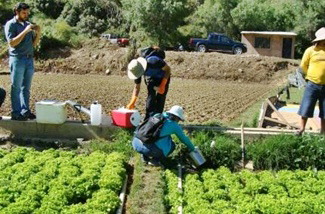
Taking crop and water samples along the Rocha River, where some farmers irrigate indirectly with untreated wastewater | 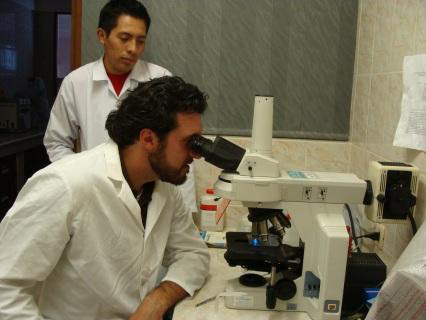
Microscopic observation of parasites from the effluence from the Rocha River samples |
This project measured concentrations of human pathogens responsible for infectious diseases, such as cryptosporidiosis, giardiasis, and helminthiasis, in water, soil, and crop samples from six community farms where wastewater is used for irrigation. The team quantified the differences in pathogen concentrations in the presence and absence of on-farm health protection measures.
Final Summary of Project ActivitiesIn the course of the project, the CASA team developed expertise in laboratory methodologies to detect the above-mentioned pathogens in environmental samples, led the laboratory analysis component, and provided graduate students with experience in data collection and field sampling. The U.S. partner at USF assisted with the design of data collection and sampling techniques in the field and collaborated academically with their Bolivian counterparts to publish results.
In the area of the Rocha River, the incidence of pathogens and pathogen indicators was very high in the river water of the river, but much lower in the irrigation wells from which
farmers draw water. Enteric viruses, on the other hand, were not found in the irrigation wells, but were detected in high concentrations in the river. The presence of parasites in the well water is outside the limits recommended by WHO for use in irrigation. The research team conducted their final sampling at the wastewater treatment plants in Punata and Arani, from the anaerobic lagoon inlet and from the outlet of the treatment plant. In both treatment plants studied it has been shown that there is a lack of proper maintenance of ponds and as a result, the removal of microorganisms is not effective. The results show similar levels of
E. coli and coliphages in the inlet and outlet of the plants.
The research team presented their results at several conferences as well as workshops to disseminate their research results to local community stakeholders. Among the recommendations offered was limiting the contamination of wells by animal waste, installing a series of stabilization ponds to store the irrigation water and providing treatment via sedimentation of parasites, and exposure to UV rays from the sunlight. At the plants, their recommendations included the installation of bar screens to prevent solids from entering the lagoons and general maintenance under a monitoring program for both plants.
At the workshop near the Rocha River, PEER grantees presented their results to a group of majority-female farmers. At the workshop in Punata, discussion with the community members focused on improvements that could be made to the treatment plant, and representatives of the water company affirmed their commitment to improving the treatment plant, with technical support from the university. At the workshop in Arani, the team presented the results collected to farmers and irrigators who used the treated wastewater, as well as representatives from the mayor’s office. Community members said they generally perform maintenance activities without any technical guidance and that the research team’s support and guidance was very helpful. The representatives from the mayor’s office noted that aside from the planned improvements to the treatment plan, their office has approved the construction of a new treatment plant in a lower area of the municipality.
The research contributed to five students’ theses and a partner researcher from USF was invited by the Center to help deliver a short course entitled, "Introduction to quantitative microbial risk assessment for water reuse in agriculture."
PublicationsVerbyla, M.E., Kafle, R.C., Symonds, E.M., Cairns, M.R., Iriarte, M., Mihelcic, J.R. 2014. A quantitative microbial risk assessment for lettuce irrigated with wastewater treated by on-farm bank filtration systems in Bolivia. Oral Presentation, 2014 Water Microbiology Conference: Microbial contaminants from watersheds to human exposure, May 5-7, 2014, Chapel Hill, North Carolina.
Verbyla, M.E., Oakley, S.M., Iriarte, M., Lizima, L., Zhang, J., Tejada-Martinez, A.E., and Mihelcic, J.R. 2013, Taenia eggs in a stabilization pond system with poor hydraulics: Concern for human cysticercosis?
Water Science & Technology 68(12): 2698-2703.
Iriarte, M., Mercado, A., Verbyla, M.E., Almanza, M., Fuentes, G., Rocha, J.C. 2013. Monitoreo de microorganismos indicadores y patógenos en dos sistemas de lagunas de estabilización en el Valle Alto de Cochabamba. (Monitoring pathogens and pathogen indicators in two waste stabilization pond systems in the Upper Cochabamba Valley).
Proceedings of the XV Congreso Bolivariano de Ingeniería Sanitaria y Medio Ambiente, ABIS-AIDIS, November 20-22, 2013, Cochabamba, Bolivia.
Mercado, A.R., Coronado Rocha, J.O., Iriarte, M. 2013. Evaluación del funcionamiento de la planta de tratamiento de aguas residuales de Punata, Cochabamba, Bolivia. Importancia de la operación y mantenimiento. (Evaluation of the Punata wastewater treatment plant in Cochabamba, Bolivia. Importance of operation and maintenance).
Proceedings of the XV Congreso Bolivariano de Ingeniería Sanitaria y Medio Ambiente, ABIS-AIDIS, November 20-22, 2013, Cochabamba, Bolivia.
Verbyla, M.E., Oakley, S.M., Iriarte, M., Lizima, L., Zhang, J., Tejada-Martinez, A.E., and Mihelcic, J.R. 2013. The removal of Taenia and Ascaris eggs from waste stabilization ponds
and the impact of pond hydraulics. Oral Presentation, 10th IWA Specialist Group Conference on Wastewater Pond Technology, August 19-22, 2013, Cartagena, Colombia.
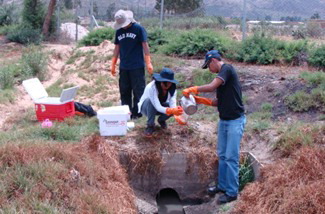 Sampling point at the entrance of the Arani Wastewater Treatment Plant, Sampling point at the entrance of the Arani Wastewater Treatment Plant,
photo courtesy of Dr. Iriarte. | 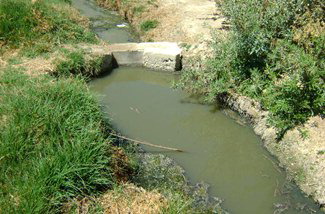 Sampling point, effluent of the Punata Wastewater Treatment Plant, Sampling point, effluent of the Punata Wastewater Treatment Plant,
photo courtesy of Dr. Iriarte. |
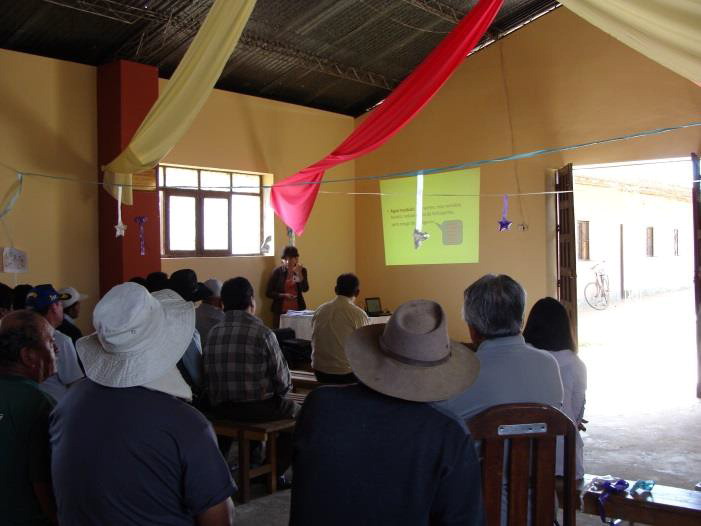
Presentation at the church in Punata, photo courtesy of Dr. Iriarte.
| 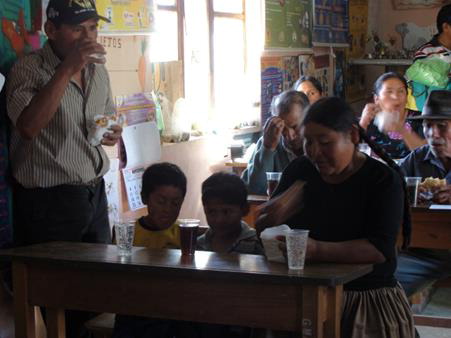
Workshop at a school in Arani, photo courtesy of Dr. Iriarte.
|
Back to PEER Cycle 1 Grant Recipients









